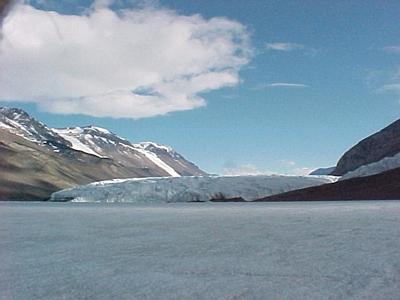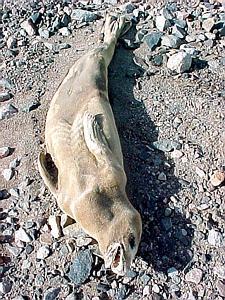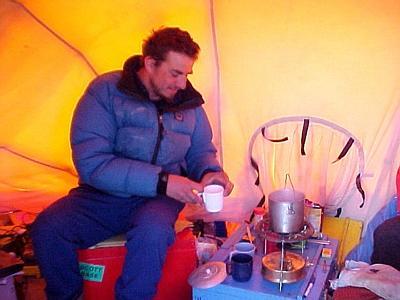
|
|
28 November, 1999
West Lobe, Lake Bonney
Lake Bonney is divided into two distinct lobes, each a misshapen kidney
bean. Our camp is situated on the south shore of the east lobe. I hadn't
ventured too far from camp yet, so Peter took me on a tour of the lake via
the All Terrain Vehicle (ATV) we have for driving on the ice. First we
drove all the way out to the farthest eastern point, then we bumped over
the uneven surface of the moat towards the westernmost reach.

The Taylor glacier feeds into Lake Bonney at its western border.

For some mysterious reason, an occasional wayward crabeater seal crawls miles from the sea, up into the valley and perishes here, hungry and lost. We found this one on the scree near the glacier. Since the air is so cold and dry, the seal's body mummifies and can last, intact, for centuries. Judging from the good condition of its pelt, this seal probably died within the last hundred or so years.

The glacier produces meltwater streams when the weather warms up. The streams flow into the lake. Where water meets ice, the soils become saturated and muddy, with a sucking quality like quicksand.

Blood Falls is famous for the rust-colored ice pouring off the glacial front. Scientists seem to disagree on the cause of the red coloration I've heard two different reasons. One, it's caused by an algae living on the ice, and two, the tint is from iron oxides coming off the mountain. These glaciologists are living at the kiwi camp at the base of the glacier.

The kiwi program doesn't have the same kind of elaborate technical support the American program has. They generally live a bit closer to the land. This is Andrew, a micro-meteorologist who studies changes in local weather close to the surface. We are sitting in his group's cook tent, and have just been invited for tea.
Contact the TEA in the field at
.
If you cannot connect through your browser, copy the
TEA's e-mail address in the "To:" line of
your favorite e-mail package.
|
